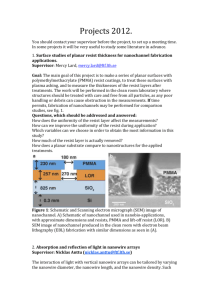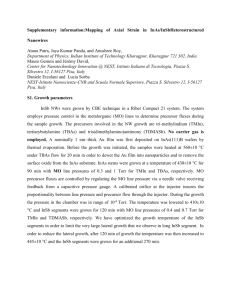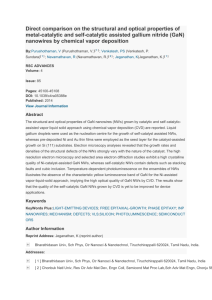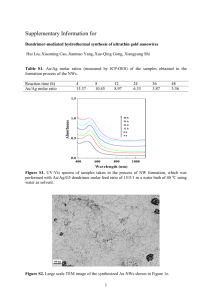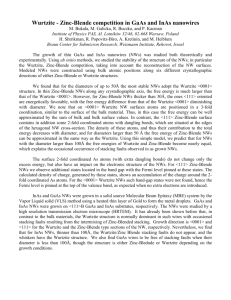6a.
advertisement
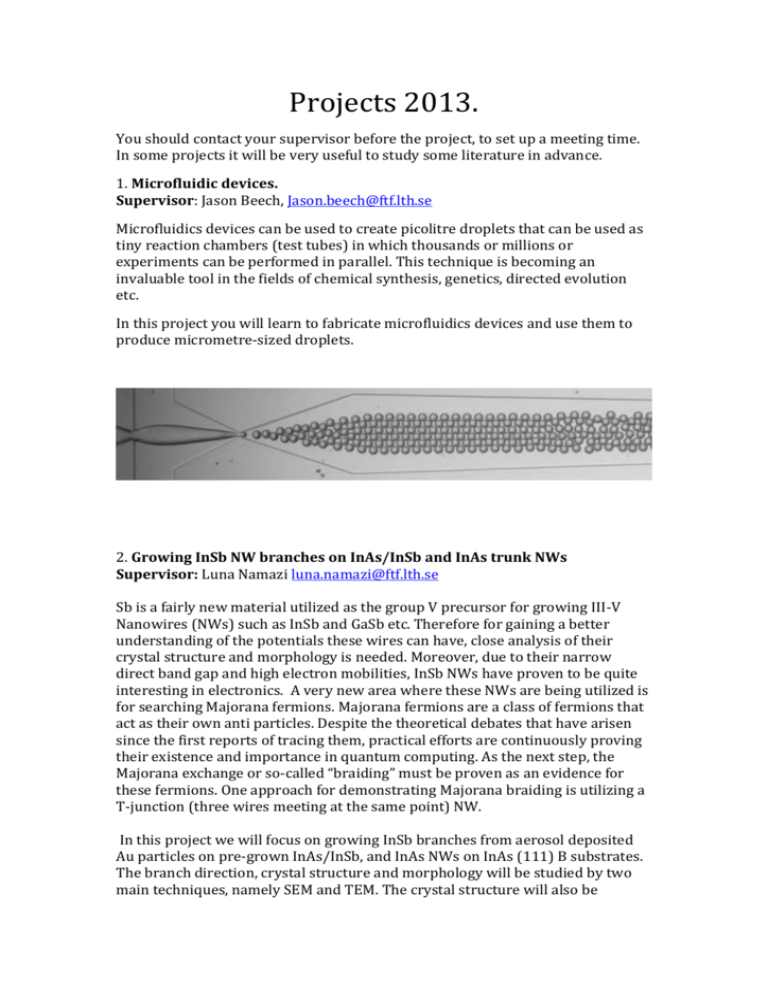
Projects 2013. You should contact your supervisor before the project, to set up a meeting time. In some projects it will be very useful to study some literature in advance. 1. Microfluidic devices. Supervisor: Jason Beech, Jason.beech@ftf.lth.se Microfluidics devices can be used to create picolitre droplets that can be used as tiny reaction chambers (test tubes) in which thousands or millions or experiments can be performed in parallel. This technique is becoming an invaluable tool in the fields of chemical synthesis, genetics, directed evolution etc. In this project you will learn to fabricate microfluidics devices and use them to produce micrometre-sized droplets. 2. Growing InSb NW branches on InAs/InSb and InAs trunk NWs Supervisor: Luna Namazi luna.namazi@ftf.lth.se Sb is a fairly new material utilized as the group V precursor for growing III-V Nanowires (NWs) such as InSb and GaSb etc. Therefore for gaining a better understanding of the potentials these wires can have, close analysis of their crystal structure and morphology is needed. Moreover, due to their narrow direct band gap and high electron mobilities, InSb NWs have proven to be quite interesting in electronics. A very new area where these NWs are being utilized is for searching Majorana fermions. Majorana fermions are a class of fermions that act as their own anti particles. Despite the theoretical debates that have arisen since the first reports of tracing them, practical efforts are continuously proving their existence and importance in quantum computing. As the next step, the Majorana exchange or so-called “braiding” must be proven as an evidence for these fermions. One approach for demonstrating Majorana braiding is utilizing a T-junction (three wires meeting at the same point) NW. In this project we will focus on growing InSb branches from aerosol deposited Au particles on pre-grown InAs/InSb, and InAs NWs on InAs (111) B substrates. The branch direction, crystal structure and morphology will be studied by two main techniques, namely SEM and TEM. The crystal structure will also be checked by Raman scattering. Furthermore, based on the yield statistical analysis of the length and diameter of the branch in comparison to the trunk can be carried out. IMPORTANT NOTE. The fabrication of the wires will be done early in week 48 so you should be available then to start the project. 3. Time-resolved PL study of surface passivation in NWs. Supervisor: Dr. Arkady Yartsev, email: arkady.yartsev@chemphys.lu.se In the project, one will be taught how to use a set-up for time-resolved PL measurements. Our set-up includes a PL excitation source (tunable short-pulse laser (Tsunami, Spectra-Physics) with second- and third- harmonic generation and pulse-picker for the repletion rate reduction), a set of optical elements for transferring the laser light to the sample under study and the PL detector based on Streak-camera coupled with a spectrograph. With this set-up, one can measure PL dynamics with ~1 ps temporal resolution and over 2 ns time interval. The PL spectra can be measured over a broad spectral range from 300 to 950 nm. By means of this set-up, you will measure PL dynamics in InP NWs. We have recently shown that the PL dynamics in this type of NWs is highly sensitive to the presence of trap states at the NW surface. Therefore, this technique can be used for studying the nature of traps in NWs and for optimization of the NW passivation procedures. During passivation, the NW undergoes a variety of modifications aimed at reduction of the surface trap concentration. Passivation may include various methods of the NW surface protection to avoid trap formation or NW treatment to remove traps from the surface. You will be asked to modify the trap concentration on InP NWs by changing the NW environment (for example, by using different gases, such as air, O2, N2, etc.), by irradiation of NWs with pulsed- or cw-laser radiation of different colour and by a combination of these two methods. Different treatments of the NWs will result in variation of the PL decay, which you will measure by the Streak-camera and analyse by the available software packages. The tasks of the project will be: • Learn the set-up for time-resolved PL measurements. • Identify NW environments that induce and remove surface traps on asgrown NWs. • Compare trap influence and trap removal for as-grown and SiO2 protected NWs. 4. Coulomb blockade with rate equations Supervisor: Martin Leijnse: martin.leijnse@ftf.lth.se In this project you will write a small computer program to calculate the conductance of a quantum dot with discrete energy levels and a large charging energy. Coulomb diamonds appear when the conductance is plotted as a function of bias and gate voltages. We will focus on the regime of small tunnel couplings, where the electrons tunnel one by one through the quantum dot and the mathematics becomes relatively simple. However, to obtain the correct shape of the conductance lines (not just their position in the Coulomb diamond), it is necessary to solve a so-called rate equation for the state of the quantum dot. Basically, driving a current through the dot can put it in an excited state (currentinduced heating), which acts back on the current. You will investigate the effects of an applied magnetic field, and look at multi-level dots with asymmetric tunnel couplings which can give rise to spectacular effects such as negative differential conductance and current blockade. 5. Calculation of the band-structure of GaAs using k.p-theory Supervisor: Mats-Erik Pistol, mats-erik.pistol@ftf.lth.se In this theory project we will calculate the conduction and valence band structure of GaAs using a quite sophisticated 8-band k.p-model. This is the standard model to calculate bandstructure and is described to some extent in Davies book. We will also include strain in the model to see how the light and heavy hole in the valence band maximum split in energy when we strain the crystal. 6a. Optical properties of truncated GaN-pyramid with InGaN quantum wells using photoluminescence spectroscopy. Supervisor: David Lindgren, david.lindgren@ftf.lth.se We will study the optical properties of truncated GaN-pyramids with InGaN QWs using photoluminescence spectroscopy. Cathodoluminescence (CL) imaging and spectroscopy could also take part in project. Such a complementary measurement could be useful for further analysis of the optical properties, such as the spatial origin of the luminescence. However, there is a big maybe if the CL system will be ready to operate, since it is down at the moment. 6b. Simulation of the emission energy as a function of QW thickness in a GaN/InGaN heterostructure. Supervisor: David Lindgren, david.lindgren@ftf.lth.se In this project the students will simulate the transition energy in quantum well structures using the effective mass approximation. This project group is encouraged to use data from project 6a in order to compare theory with experiments on similar structures. It will thus be possible to extract the effective masses in these very unknown materials. This project group will also join when (if) the CL measurements are performed, as mentioned in the project 6 description. 7. Blinking quantum dots Supervisor: Neimantas Vainorius, neimantasv@gmail.com In this project we will investigate individual quantum dots of InP using photoluminescense. It has been found that these dots blink on a quite long timescale. We will measure a set of these blinking dots and the try to find any statistics of the blinking. We will also see if there are several types of blinkers. 8. The effect of nanowire geometry on the reflectivity spectrum Supervisor: Mahtab Aghaeipour Kolyani: mahtab.aghaeipour_kolyani@ftf.lth.se How to reduce the reflection of nanowire arrays is challenging. Designing suitable dimensions of nanowire arrays solves this problem. In this project, we will show that increasing the diameter of the nanowires in the arrays leads to lower reflectivity. In order to measure the reflectivity spectrum of nanowire arrays, we use a Filmetrics thin-film analyzer. The measurements will be performed in the wavelength range of 200 nm to 1100 nm. The light is normally incident toward the sample through an objective with NA = 0.28, and reflected light is collected with the same objective. 9. Investigation of the Electro-Optical properties of Indium Tin Oxide (ITO) thin films, under different deposition conditions. Supervisor: Ali Nowarzi, Ali.Nowzari@ftf.lth.se Indium Tin Oxide (ITO) thin films, are used extensively as a transparent contact in the fabrication of electro-optical devices such as LEDs, Photodetectors and Solar cells. In this project, for different deposition conditions, we like to investigate the electrical properties of ITO thin films, mainly sheet resistance, using 4-probe method, while comparing the electrical characterization results with the optical properties, mainly transmittance, trying to find an optimized deposition condition to obtain a transparent and conductive contact.
